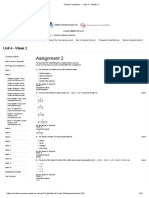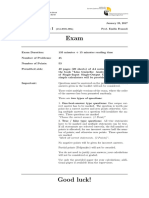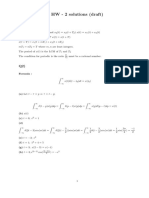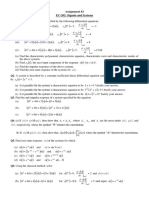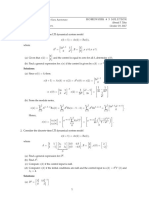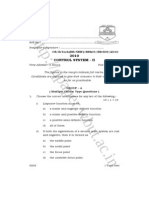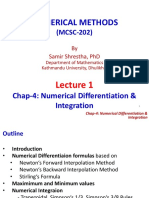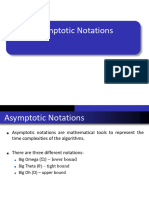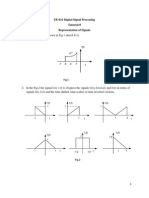Week 2: Assignment 2
Assignment not submitted Due date: 2024-08-07, 23:59 IST.
The response of a system to non-zero initial conditions is called 1 point
forced response
transient response
free response
steady state response
A second order system is governed by ÿ (t) + 2ẏ (t) = u(t) 𝑦(𝑡)
¨ + 2𝑦(𝑡)
˙ = 𝑢(𝑡). Its transfer function is 1 point
1 1
2+2
s2 +2 𝑠
1 1
s 2 − 2 𝑠2 − 2
1 1
s 2 + 2s 𝑠2 + 2𝑠
1 1
s 2 − 2s 𝑠2 − 2𝑠
The order of the numerator polynomial is ________ the order of the denominator polynomial in a strictly proper transfer function. 1 point
greater than
lesser than
greater than or equal to
lesser than or equal to
The poles of the transfer function of the system whose governing equation is 1 point
ÿ (t) + 2ẏ (t) − 3y(t) = ü (t) + 5u̇ (t) + 4u(t) 𝑦(𝑡)
¨ + 2𝑦(𝑡)
˙ − 3𝑦(𝑡) = 𝑢(𝑡)
¨ + 5𝑢(𝑡)
˙ + 4𝑢(𝑡), are
1, -3
-1, -3
-1, -4
-1, 4
The zeros of the transfer function of the system whose governing equation is 1 point
ÿ (t) + 2ẏ (t) − 3y(t) = ü (t) + 5u̇ (t) + 4u(t) 𝑦(𝑡)
¨ + 2𝑦(𝑡)
˙ − 3𝑦(𝑡) = 𝑢(𝑡)
¨ + 5𝑢(𝑡)
˙ + 4𝑢(𝑡), are
1, -3
-1, -3
-1, -4
-1, 4
Questions 6-8: Calculate the expression for the unit step response of the system whose governing equation is
ÿ (t) − ẏ (t) − 2y(t) = u(t) 𝑦(𝑡)
¨ − 𝑦(𝑡)
˙ − 2𝑦(𝑡) = 𝑢(𝑡).
The steady state value of the output (as time tends to infinity) is 1 point
0.25
-0.25
0.5
infinity
The coefficient of the e−t 𝑒−𝑡 term in the output function is 1 point
0.5
0.167
0.33
-0.5
The coefficient of the e2t 𝑒2𝑡 term in the output function is 1 point
0.5
0.167
0.33
-0.5
Questions 9-10: Calculate the unit step response of the system whose governing equation is ÿ (t) + 2y(t) = u(t) 𝑦(𝑡)
¨ + 2𝑦(𝑡) = 𝑢(𝑡).
The steady state value of the output (as time tends to infinity) is 1 point
� unbounded
bounded and constant
bounded and oscillatory
zero
The constant term in the output function is 1 point
0.5
0.25
2
1
Consider the system whose governing equation is ÿ (t) + 4y(t) = u(t) 𝑦(𝑡)
¨ + 4𝑦(𝑡) = 𝑢(𝑡) . The input for which the system output would be 1 point
unbounded is
11
sin(2t) sin(2𝑡)
cos(4t) cos(4𝑡)
sin(t) sin(𝑡)
Consider the system whose governing equation is ÿ (t) + 2ẏ (t) = u(t) 𝑦(𝑡)
¨ + 2𝑦(𝑡)
˙ = 𝑢(𝑡) . The input for which the system output would be 1 point
unbounded is
11
–
cos(√ 2t) cos(√ 2𝑡)
sin(2t) sin(2𝑡)
cos(t) cos(𝑡)
....
Consider the system whose governing equation is y (t) + 4ÿ (t) + 4y(t) = u(t) ⃜
𝑦(𝑡) ¨
+ 4𝑦(𝑡) + 4𝑦(𝑡) = 𝑢(𝑡) . The system output would be 1 point
unbounded for
only u(t) = 1 𝑢(𝑡) = 1
only u(t) = cos(2t) 𝑢(𝑡) = cos(2𝑡)
any bounded input
only u(t) = cos(4t) 𝑢(𝑡) = cos(4𝑡)
Consider the system whose governing equation is ÿ (t) − ẏ (t) − 2y(t) = u(t) 𝑦(𝑡)
¨ − 𝑦(𝑡)
˙ − 2𝑦(𝑡) = 𝑢(𝑡) . The system output would be unbounded for 1 point
only u(t) = 1 𝑢(𝑡) = 1
only u(t) = cos(3t) 𝑢(𝑡) = cos(3𝑡)
only u(t) = sin(t) 𝑢(𝑡) = sin(𝑡)
any bounded input
Consider
.... the
... system whose governing equation is 1 point
y (t) + 6 y (t) + 12ÿ (t) + 10ẏ (t) + 3y(t) = u(t) ⃜
𝑦(𝑡) ⃛
+ 6𝑦(𝑡) + 12𝑦(𝑡)
¨ + 10𝑦(𝑡)
˙ + 3𝑦(𝑡) = 𝑢(𝑡) . Which ONE of the following statements is TRUE?
The multiplicity of the -1 pole and -3 pole is 2 and 2 respectively
The multiplicity of the -1 pole and -3 pole is 3 and 1 respectively
The multiplicity of the -1 pole and -3 pole is 2 and 1 respectively
The multiplicity of the -1 pole and -3 pole is 1 and 2 respectively
You may submit any number of times before the due date. The final submission will be considered for grading.
